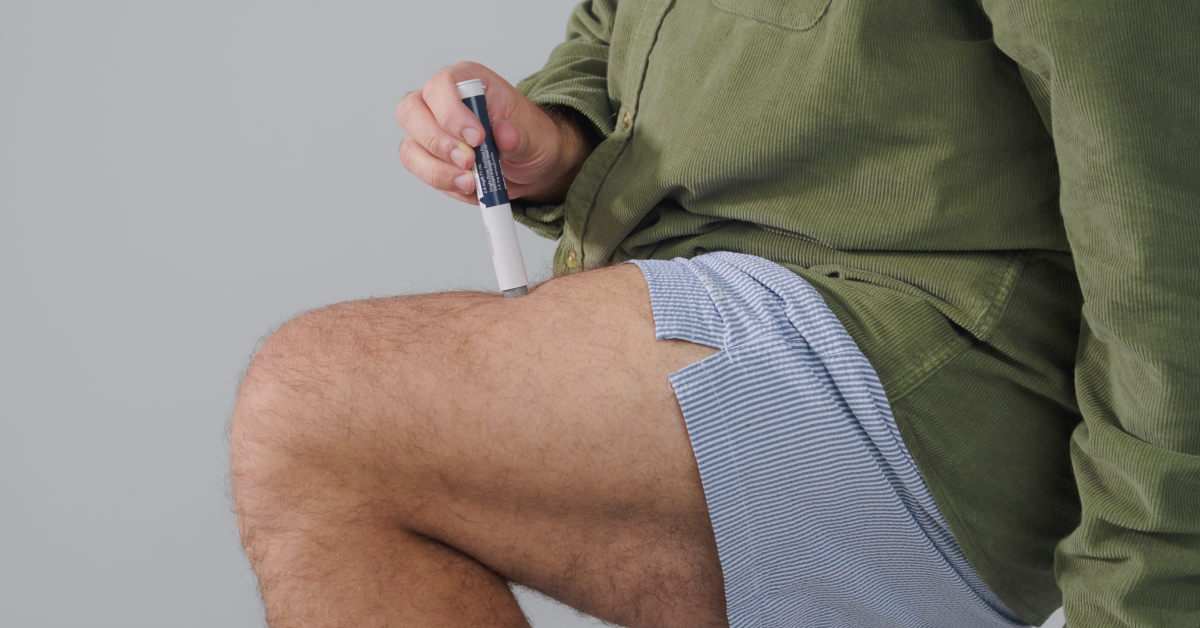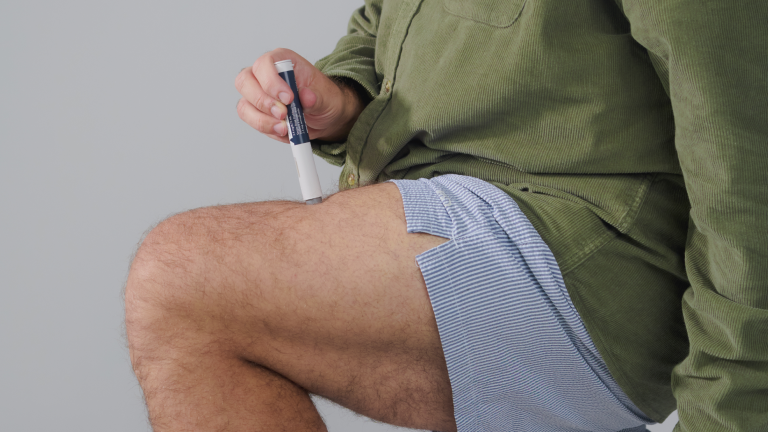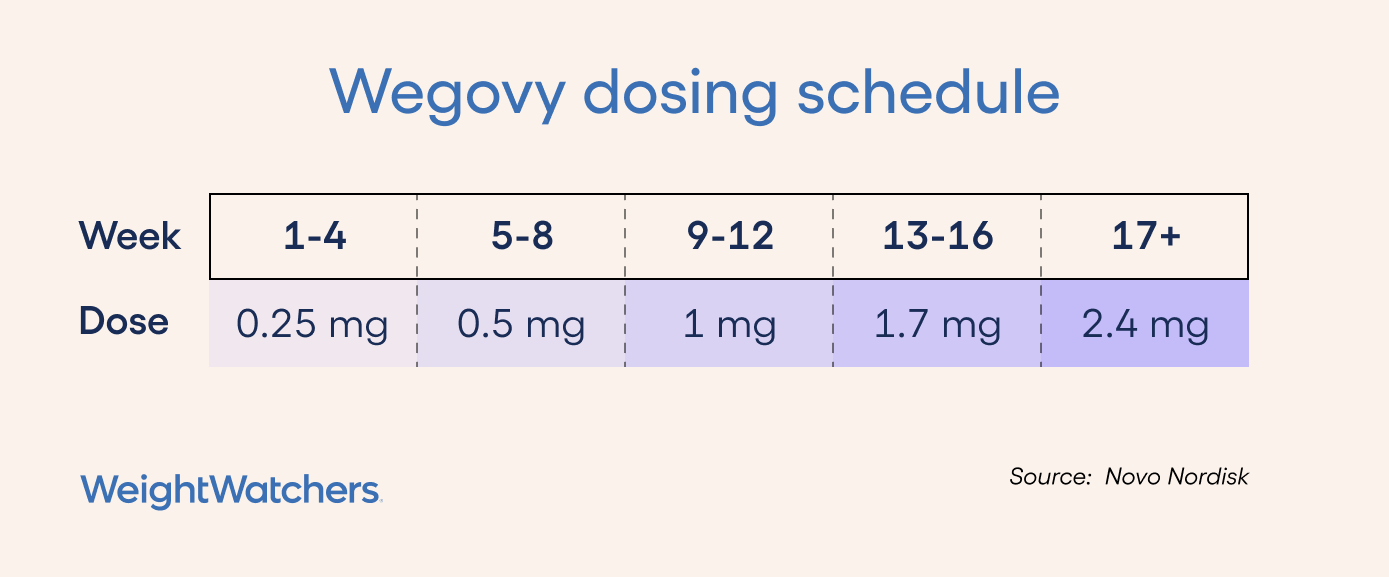Everything you need to know about Wegovy dosage


For many people who take a GLP-1 weight-loss medication like Wegovy, there’s a learning curve at first. For one — unlike the vast majority of medications — it’s taken via weekly injection instead of pill. Then there’s the matter of dosage. There are five different doses of Wegovy, the version of semaglutide that’s FDA approved for weight loss — and it’s likely you’ll take more than one. “Every patient has their own genetics and underlying factors, so some may fare better on a higher or lower dose,” says Dr. Michelle Ponder, M.D., an endocrinologist and assistant professor of medicine at Duke University School of Medicine. Finding your sweet spot — the dose where you’re steadily losing weight with least amount of side effects — takes a little guesswork. Here’s what you need to know.
Typical Wegovy dosing schedule
To start, you’ll take the smallest dose of Wegovy, which is 0.25 mg, once per week, says Dr. Rachel Pessah-Pollack, M.D., an endocrinologist and clinical professor of medicine at NYU Grossman School of Medicine. “The reason is to ensure that you can tolerate the medicine,” she says. Starting small will reduce your chances for experiencing severe Wegovy side effects, including diarrhea, nausea, headache, fatigue, and stomachaches. Find a full list of side effects on the Wegovy site.
Every month, you’ll check in with your healthcare provider either in person or online if you’re using a virtual weight-loss clinic. You’ll go over your weight loss, hunger level, cravings, and side effects. If you do well on your current dose and lose weight at about one to two pounds a week, your provider may decide to continue with that dose another month, says Dr. Eleanor Yusupov, D.O., an assistant professor and obesity medicine physician at New York Institute of Technology’s Medical School. Struggling with food noise or hunger? That’s a sign you may need to step up to the next dosage. Or, if you’re miserable because of the side effects, you may need to go back down to a lower dose.
Potential Wegovy dosage chart
The manufacturer of Wegovy, Novo Nordisk, recommends the following dosage schedule. Just know that your timeline may vary from this based on guidance from your doctor.

What strengths does Wegovy come in?
Wegovy comes in prefilled injectable pens that are available in five different strengths, each with a different colored pen:
- 0.25 mg (light green)
- 0.5 mg (pink)
- 1 mg (brown)
- 1.7 mg (blue)
- 2.4 mg (black)
How many doses are in a Wegovy pen?
“Each pen contains one dose,” says Pessah-Pollack. They’re single-use, so you dispose of the pen after you administer the medicine. To do that, put it in a sharps container (you can get these at a pharmacy or online) or a heavy-duty plastic container with a tight-fitting lid, such as an empty liquid laundry detergent jug.
Forms of Wegovy (semaglutide)
Wegovy is the brand name of the drug semaglutide. Another semaglutide is Ozempic, which is made by the same manufacturer, Novo Nordisk. But the two have some differences: Ozempic is approved by the FDA to treat type 2 diabetes in adults aged 18 and over. Wegovy is approved for weight loss for people aged 12 and older living with obesity or overweight plus a related condition, such as high blood pressure.
Both Wegovy and Ozempic are weekly injections. Another type of semaglutide, called Rybelsus, comes as a tablet that’s taken by mouth once a day. It’s FDA approved to treat type 2 diabetes, but scientists are currently studying how it works for weight loss. Research suggests that the highest dose of Rybelsus, 14 mg, taken daily may be as effective as the lowest doses (0.5 and 1 mg weekly) of injectable semaglutide in people with type 2 diabetes.
How to use Wegovy
After you pick up your Wegovy prescription, keep it in its original box and store it in the refrigerator. If needed, you can keep it at room temperature for up to 28 days. You’ll inject yourself with the medicine on the same day once a week. “Some people prefer to take it at the end of the week, so if they have any side effects, it’s over the weekend,” says Pessah-Pollack. But this is really all about preference — it doesn’t matter what time of day, and you can take Wegovy with or without food.
Because the medicine comes in a prefilled pen, it’s simple to administer. You’ll inject yourself in the upper arms, legs, or stomach. You can choose the same body part each week, but don’t use the exact same spot two times in a row. After cleaning the area with alcohol or soap and water, you’ll place the pen against your skin and push the button to inject the medicine beneath the skin. Because the needle is hidden, some patients don’t even see it, says Yusupov.
Listen for two clicks; the first means that the injection has started and the second signals that the injection is in process. Look at the yellow bar on the pen. When it stops moving, that means the injection is complete and you can lift the pen slowly.
What happens if you miss a dose of Wegovy?
If you miss a dose and your next scheduled dose is more than two days (48 hours) away, take the missed dose as soon as possible. If you’re within that 48-hour window, skip the missed dose and wait to take your next scheduled one. If you’ve missed more than two weeks of Wegovy, check in with your doctor to find out the right way to handle it. “You may need to go back to a lower dose or even the starting dose to prevent side effects,” says Ponder.
What to do if you overdose on Wegovy?
If you accidentally take two doses within 48 hours of each other, you may not feel the best. Too much Wegovy can lead to an increase in side effects like nausea, vomiting, and abdominal pain. Most of the time, you’ll recover on your own. In rare cases, these symptoms are dangerous. If you experience severe vomiting, nausea, abdominal pain, or low blood sugar, go to urgent care or the emergency room to prevent dehydration or hypoglycemia.
Can you change your Wegovy dose date?
To avoid confusion and maintain the right amount of medicine in your body, it’s best to take Wegovy on the same day each week. But you can switch days, says Ponder. The main thing to remember is not to take two doses within 48 hours of each other. So if you want to switch from taking it on Mondays to taking it on Fridays, take it as usual on a Monday and then take your next dose four days later. Moving on, take your weekly doses on Fridays.
The bottom line
There are five different doses of Wegovy, ranging from 0.25 mg to 2.4 mg. When you start taking Wegovy, you’ll begin with the smallest dose and gradually increase that amount every month. This approach helps your body adjust to the medicine and reduce the side effects. But everyone’s body is different, so you’ll work together with your doctor to find the best Wegovy dosage schedule for you.
FAQs
No, says Ponder. Although scientists are evaluating the safety and efficacy of higher doses of Wegovy, they’re not available or recommended.
“In general, higher doses are stronger and lead to greater weight loss,” says Ponder. One study of people with type 2 diabetes showed that those taking 1.7 mg of semaglutide weekly lost about 7 percent of their body weight after four months and those taking 2.4 mg lost an average of 9.7 percent of their body weight.
While you will likely find that you lose weight relatively quickly on Wegovy — around 1 to 2 pounds a week — healthy habits can help keep that weight loss going. This means combining the medication with eating a healthy diet and exercising regularly. “The recommendation is 150 minutes of moderate exercise and two strength training sessions weekly,” says Ponder. “It’s important to build muscle, so you’re not losing muscle along with fat.”
This content is for informational purposes only and does not constitute medical advice, diagnosis or treatment. It should not be regarded as a substitute for guidance from your healthcare provider.
